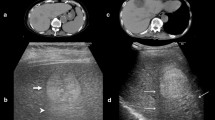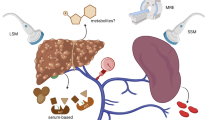Abstract
Objective
To develop and validate a nomogram based on liver stiffness (LS) for predicting symptomatic post-hepatectomy (PHLF) in patients with hepatocellular carcinoma (HCC).
Methods
A total of 266 patients with HCC were enrolled prospectively from three tertiary referral hospitals from August 2018 to April 2021. All patients underwent preoperative laboratory examination to obtain parameters of liver function. Two-dimensional shear wave elastography (2D-SWE) was performed to measure LS. Three-dimensional virtual resection obtained the different volumes including future liver remnant (FLR). A nomogram was developed by using logistic regression and determined by receiver operating characteristic (ROC) curve analysis and calibration curve analysis, which was validated internally and externally.
Results
A nomogram was constructed with the following variables: FLR ratio (FLR of total liver volume), LS greater than 9.5 kPa, Child–Pugh grade, and the presence of clinically significant portal hypertension (CSPH). This nomogram enabled differentiation of symptomatic PHLF in the derivation cohort (area under curve [AUC], 0.915), internal fivefold cross-validation (mean AUC, 0.918), internal validation cohort (AUC, 0.876) and external validation cohort (AUC, 0.845). The nomogram also showed good calibration in the derivation, internal validation, and external validation cohorts (Hosmer–Lemeshow goodness-of-fit test, p = 0.641, p = 0.06, and p = 0.127, respectively). Accordingly, the safe limit of the FLR ratio was stratified using the nomogram.
Conclusion
An elevated level of LS was associated with the occurrence of symptomatic PHLF in HCC. A preoperative nomogram integrating LS, clinical and volumetric features was useful in predicting postoperative outcomes in patients with HCC, which might help surgeons in the management of HCC resection.
Clinical relevance statement
A serial of the safe limit of the future liver remnant was proposed by a preoperative nomogram for hepatocellular carcinoma, which might help surgeons in ‘how much remnant is enough in liver resection’.
Key Points
• An elevated liver stiffness with the best cutoff value of 9.5 kPa was associated with the occurrence of symptomatic post-hepatectomy liver failure in hepatocellular carcinoma.
• A nomogram based on both quality (Child–Pugh grade, liver stiffness, and portal hypertension) and quantity of future liver remnant was developed to predict symptomatic post-hepatectomy liver failure for HCC, which enabled good discrimination and calibration in both derivation and validation cohorts.
• The safe limit of future liver remnant volume was stratified using the proposed nomogram, which might help surgeons in the management of HCC resection.



Similar content being viewed by others
Abbreviations
- CSPH:
-
Clinically significant portal hypertension
- FLR:
-
Future liver remnant
- HCC:
-
Hepatocellular carcinoma
- LS:
-
Liver stiffness
- PHLF:
-
Post-hepatectomy liver failure
References
Sung H, Ferlay J, Siegel RL et al (2021) Global Cancer Statistics 2020: GLOBOCAN estimates of incidence and mortality worldwide for 36 cancers in 185 countries. CA Cancer J Clin 71:209–249
Belghiti J, Fuks D (2012) Liver resection and transplantation in hepatocellular carcinoma. Liver Cancer 1:71–82
Søreide JA, Deshpande R (2021) Post hepatectomy liver failure (PHLF) - recent advances in prevention and clinical management. Eur J Surg Oncol 47:216–224
Rahbari NN, Garden OJ, Padbury R et al (2011) Posthepatectomy liver failure: a definition and grading by the International Study Group of Liver Surgery (ISGLS). Surgery 149:713–724
Prodeau M, Drumez E, Duhamel A et al (2019) An ordinal model to predict the risk of symptomatic liver failure in patients with cirrhosis undergoing hepatectomy. J Hepatol 71:920–929
van den Broek MA, Olde Damink SW, Dejong CH et al (2008) Liver failure after partial hepatic resection: definition, pathophysiology, risk factors and treatment. Liver Int 28:767–780
Wigmore SJ, Redhead DN, Yan XJ et al (2001) Virtual hepatic resection using three-dimensional reconstruction of helical computed tomography angioportograms. Ann Surg 233:221–226
Mise Y, Hasegawa K, Satou S et al (2018) How has virtual hepatectomy changed the practice of liver surgery?: Experience of 1194 virtual hepatectomy before liver resection and living donor liver transplantation. Ann Surg 268:127–133
Guglielmi A, Ruzzenente A, Conci S, Valdegamberi A, Iacono C (2012) How much remnant is enough in liver resection? Dig Surg 29:6–17
Zou H, Wen Y, Yuan K, Miao XY, Xiong L, Liu KJ (2018) Combining albumin-bilirubin score with future liver remnant predicts post-hepatectomy liver failure in HBV-associated HCC patients. Liver Int 38:494–502
Asenbaum U, Kaczirek K, Ba-Ssalamah A et al (2018) Post-hepatectomy liver failure after major hepatic surgery: not only size matters. Eur Radiol 28:4748–4756
Chuang YH, Ou HY, Lazo MZ et al (2018) Predicting post-hepatectomy liver failure by combined volumetric, functional MR image and laboratory analysis. Liver Int 38:868–874
Herrmann E, de Lédinghen V, Cassinotto C et al (2018) Assessment of biopsy-proven liver fibrosis by two-dimensional shear wave elastography: an individual patient data-based meta-analysis. Hepatology 67:260–272
Wang J, Wang Q, Yu G, She Q, Zhang W, Zhang J (2018) Correlation between liver stiffness measured by shear wave elastography and Child-Pugh classification. J Ultrasound Med 37:2191–2199
Long H, Xu W, Zhong X et al (2022) Feasibility of liver stiffness measured using two-dimensional shear wave elastography in assessing preoperative liver function for patients with hepatocellular carcinoma. Abdom Radiol (NY) 47:664–671
Long H, Zhong X, Su L et al (2021) Liver stiffness measured by two-dimensional shear wave elastography for predicting symptomatic post-hepatectomy liver failure in patients with hepatocellular carcinoma. Ann Surg Oncol 29(1):327–336. https://doi.org/10.1245/s10434-021-10563-4
Heimbach JK, Kulik LM, Finn RS et al (2018) AASLD guidelines for the treatment of hepatocellular carcinoma. Hepatology 67:358–380
Forner A, Reig M, Bruix J (2018) Hepatocellular carcinoma. Lancet 391:1301–1314
Xie DY, Ren ZG, Zhou J, Fan J, Gao Q (2020) 2019 Chinese clinical guidelines for the management of hepatocellular carcinoma: updates and insights. Hepatobiliary Surg Nutr 9:452–463
Dietrich CF, Bamber J, Berzigotti A et al (2017) EFSUMB guidelines and recommendations on the clinical use of liver ultrasound elastography, Update 2017 (Long Version). Ultraschall Med 38:e16–e47
Serenari M, Han KH, Ravaioli F et al (2020) A nomogram based on liver stiffness predicts postoperative complications in patients with hepatocellular carcinoma. J Hepatol 73:855–862
Wu M, Wu L, Jin J et al (2020) Liver stiffness measured with two-dimensional shear-wave elastography is predictive of liver-related events in patients with chronic liver disease due to hepatis B viral infection. Radiology 295:353–360
Hung HH, Su CW, Lai CR et al (2010) Fibrosis and AST to platelet ratio index predict post-operative prognosis for solitary small hepatitis B-related hepatocellular carcinoma. Hepatol Int 4:691–699
Shimada S, Kamiyama T, Orimo T et al (2020) Long-term prognostic factors of patients with hepatocellular carcinoma who survive over 10 years after hepatectomy. J Surg Oncol 121:1209–1217
Tsochatzis EA, Gurusamy KS, Ntaoula S, Cholongitas E, Davidson BR, Burroughs AK (2011) Elastography for the diagnosis of severity of fibrosis in chronic liver disease: a meta-analysis of diagnostic accuracy. J Hepatol 54:650–659
Aksakal M, Oktar SO, Sendur HN et al (2021) Diagnostic performance of 2D shear wave elastography in predicting liver fibrosis in patients with chronic hepatitis B and C: a histopathological correlation study. Abdom Radiol (NY) 46:3238–3244
Gatos I, Drazinos P, Yarmenitis S, Theotokas I, Zoumpoulis PS (2020) Comparison of sound touch elastography, shear wave elastography and vibration-controlled transient elastography in chronic liver disease assessment using liver biopsy as the “reference standard.” Ultrasound Med Biol 46:959–971
Ronot M, Ferraioli G, Müller HP et al (2021) Comparison of liver stiffness measurements by a 2D-shear wave technique and transient elastography: results from a European prospective multi-centre study. Eur Radiol 31:1578–1587
Yoo HW, Kim SG, Jang JY et al (2022) Two-dimensional shear wave elastography for assessing liver fibrosis in patients with chronic liver disease: a prospective cohort study. Korean J Intern Med 37:285–293
Cescon M, Colecchia A, Cucchetti A et al (2012) Value of transient elastography measured with FibroScan in predicting the outcome of hepatic resection for hepatocellular carcinoma. Ann Surg 256:706–712 (discussion 712–703)
Shen Y, Zhou C, Zhu G et al (2017) Liver stiffness assessed by shear wave elastography predicts postoperative liver failure in patients with hepatocellular carcinoma. J Gastrointest Surg 21:1471–1479
Nishio T, Taura K, Koyama Y et al (2016) Prediction of posthepatectomy liver failure based on liver stiffness measurement in patients with hepatocellular carcinoma. Surgery 159:399–408
Kennedy P, Wagner M, Castéra L et al (2018) Quantitative elastography methods in liver disease: current evidence and future directions. Radiology 286:738–763
Zhou X, Rao J, Wu X, Deng R, Ma Y (2021) Comparison of 2-D Shear Wave Elastography and Point Shear Wave Elastography for Assessing liver fibrosis. Ultrasound Med Biol 47:408–427
Hu H, Han H, Han XK, Wang WP, Ding H (2018) Nomogram for individualised prediction of liver failure risk after hepatectomy in patients with resectable hepatocellular carcinoma: the evidence from ultrasound data. Eur Radiol 28:877–885
Berardi G, Morise Z, Sposito C et al (2020) Development of a nomogram to predict outcome after liver resection for hepatocellular carcinoma in Child-Pugh B cirrhosis. J Hepatol 72:75–84
Citterio D, Facciorusso A, Sposito C, Rota R, Bhoori S, Mazzaferro V (2016) Hierarchic interaction of factors associated with liver decompensation after resection for hepatocellular carcinoma. JAMA Surg 151:846–853
Funding
This research was supported by the Natural Science Foundation of Guangdong Province (Grant No. 2021A1515012367, No. 2023A1515012464), and the Major Program of the National Natural Science Foundation of China (Grant No. 92059201).
Author information
Authors and Affiliations
Corresponding authors
Ethics declarations
Guarantor
The scientific guarantor of this publication is Prof. Xiaoyan Xie.
Conflicts of interest
The authors of this manuscript declare no relationships with any companies whose products or services may be related to the subject matter of the article. All authors declare they have no conflict of interest to disclose.
Statistics and biometry
Prof. Chen Yuming, an expert in statistics from the School of Public Health, Sun Yat-sen University, has provided statistical advice in this manuscript.
Informed consent
Written informed consent was obtained from all patients in this study.
Ethical approval
Institutional Review Board approval was obtained.
Methodology
-
prospective
-
diagnostic or prognostic study
-
performed at three institutions
Additional information
Publisher's note
Springer Nature remains neutral with regard to jurisdictional claims in published maps and institutional affiliations.
Supplementary Information
Below is the link to the electronic supplementary material.
Rights and permissions
Springer Nature or its licensor (e.g. a society or other partner) holds exclusive rights to this article under a publishing agreement with the author(s) or other rightsholder(s); author self-archiving of the accepted manuscript version of this article is solely governed by the terms of such publishing agreement and applicable law.
About this article
Cite this article
Long, H., Peng, C., Ding, H. et al. Predicting symptomatic post-hepatectomy liver failure in patients with hepatocellular carcinoma: development and validation of a preoperative nomogram. Eur Radiol 33, 7665–7674 (2023). https://doi.org/10.1007/s00330-023-09803-w
Received:
Revised:
Accepted:
Published:
Issue Date:
DOI: https://doi.org/10.1007/s00330-023-09803-w




